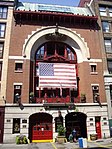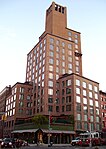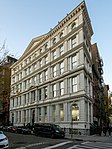Firehouse, Engine Company 33 and Ladder Company 9
1899 establishments in New York CityBuildings and structures on the National Register of Historic Places in ManhattanFire stations completed in 1899Fire stations in New York CityFire stations on the National Register of Historic Places in New York (state) ... and 1 more
New York City Designated Landmarks in Manhattan

Firehouse, Engine Company 33 and Ladder Company 9 is a New York City Fire Department firehouse at 42 Great Jones Street in NoHo, Manhattan. It is the home of Engine Company 33 and Ladder Company 9. The building is a Beaux Arts structure built in 1899 by Ernest Flagg and W.B. Chambers.
Excerpt from the Wikipedia article Firehouse, Engine Company 33 and Ladder Company 9 (License: CC BY-SA 3.0, Authors, Images).Firehouse, Engine Company 33 and Ladder Company 9
Great Jones Street, New York Manhattan
Geographical coordinates (GPS) Address External links Nearby Places Show on map
Geographical coordinates (GPS)
| Latitude | Longitude |
|---|---|
| N 40.726852 ° | E -73.992547 ° |
Address
FDNY Engine 33/Ladder 9
Great Jones Street 42
10012 New York, Manhattan
New York, United States
Open on Google Maps




